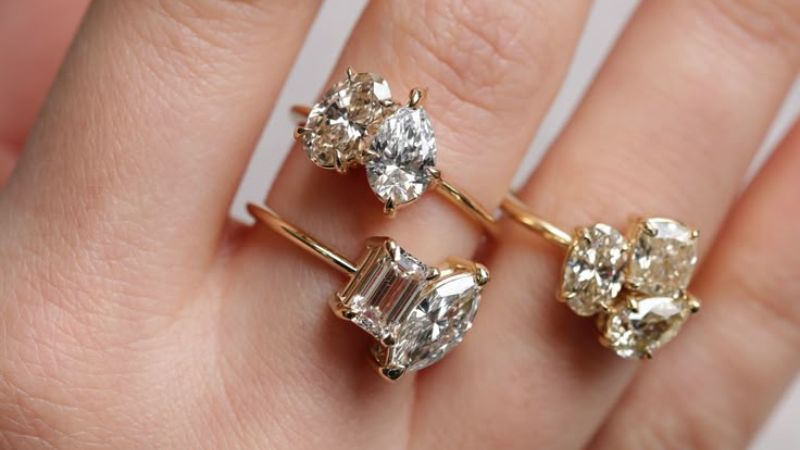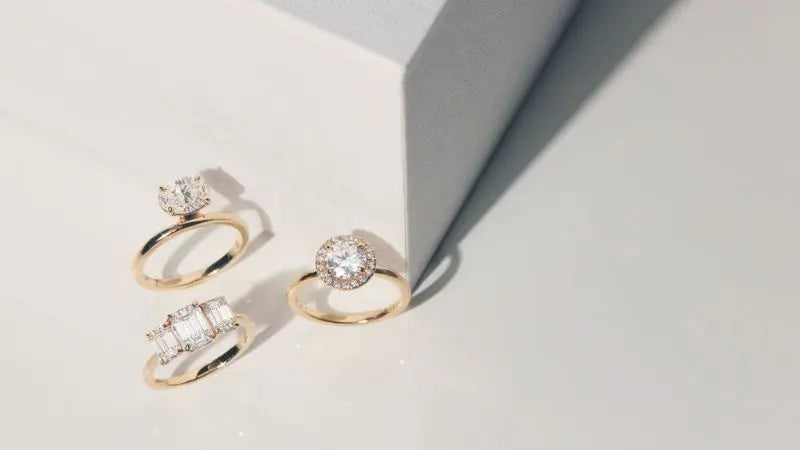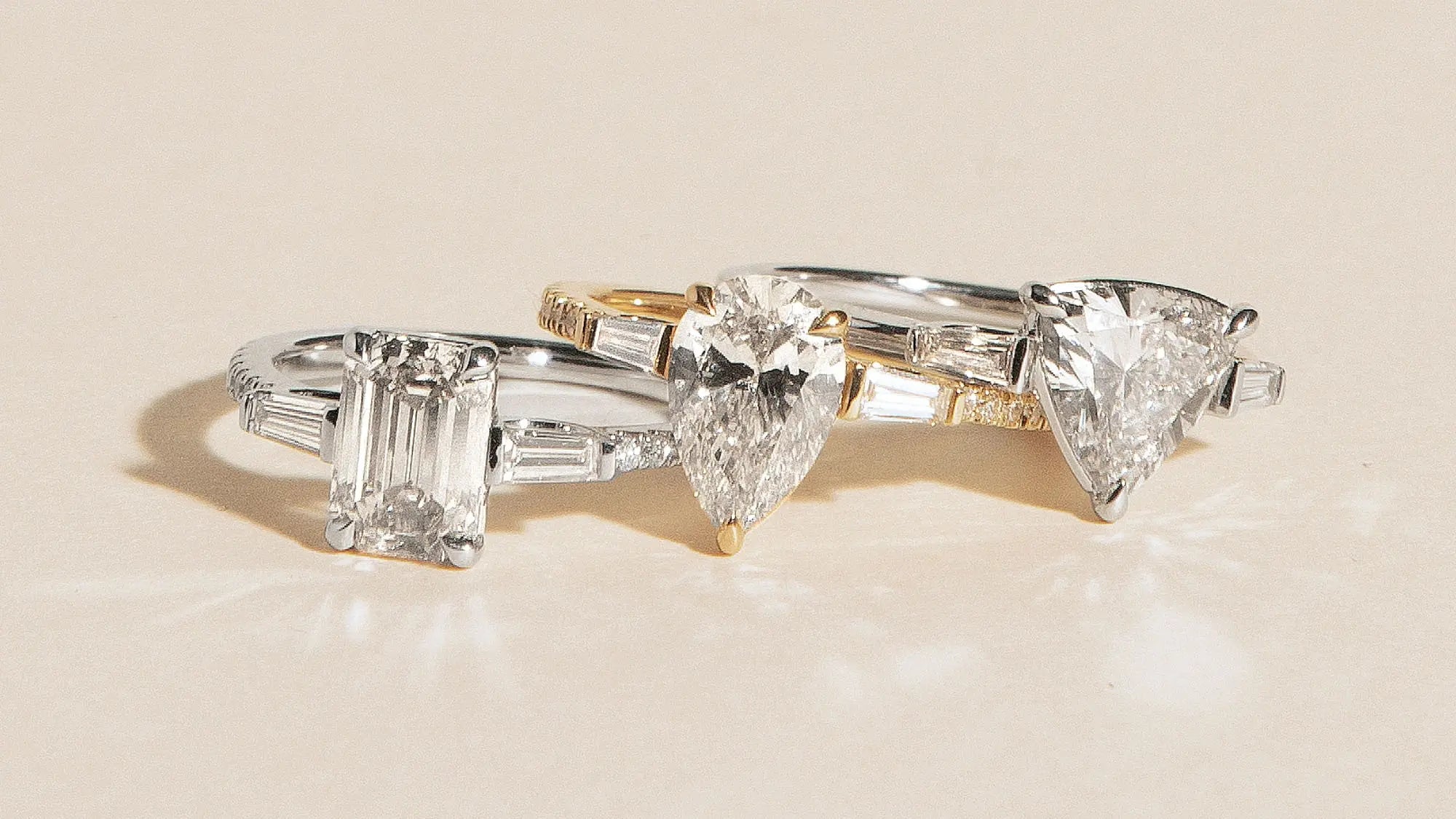Up To $2,500 OFF at checkout - Ends Dec 12
Free 30-day Returns | Lifetime Warranty
1. Introduction
Every love story begins with a single promise—the commitment to forever. And that promise is often marked by the glittering brilliance of a ring that speaks volumes without a single word.
As modern couples seek exceptional beauty, lasting value, and meaningful impact, the allure of lab engagement rings has never been stronger.
Lab-grown diamond engagement rings offer the same captivating sparkle as their mined counterparts, but with an origin rooted in innovation, ethics, and sustainability.
Through this guide curated by KNT Jewelry—where craftsmanship and emotion meet—explore whether a lab-grown diamond ring is the forever piece your love story deserves.
From science and sparkle to sustainability and style, we unveil everything you need to know before choosing your engagement ring with purpose.
2. What is a lab-grown diamond?
2.1. Are lab diamonds real diamonds?

Yes—lab-grown diamonds are 100% real diamonds. They are not imitations or substitutes. Instead, they contain the same carbon crystal structure, hardness, and optical brilliance as mined diamonds.
The primary difference lies in their origin: lab-grown diamonds are cultivated in technologically advanced laboratories rather than extracted from the earth.
This scientific advancement has allowed modern jewelers like KNT Jewelry to offer ethically sourced diamonds with all the emotional and visual weight of traditional diamonds—just without the environmental impact.
2.2. The rise in popularity of lab-grown diamond engagement rings
Over the past decade, lab-grown engagement rings have seen a remarkable rise in popularity. This shift is driven by a new generation of couples—conscious, connected, and captivated by innovation.
According to a recent survey by Brides.com, over 60% of millennial couples now consider lab-created diamonds when shopping for an engagement ring.
At KNT Jewelry, we’ve seen this trend grow—driven not only by cost-effectiveness but by the desire to celebrate love through something meaningful, beautiful, and responsibly made.
2.3. Natural vs. lab-grown diamonds at a glance

- Origin: Natural diamonds form over billions of years in the earth; lab-grown diamonds form over weeks in a lab.
- Composition: Identical physical, chemical, and optical properties.
- Value: Natural diamonds often command higher prices due to rarity, while lab-grown offer greater affordability.
- Ethics: Lab-grown diamonds are conflict-free and sustainably created, appealing to modern values and eco-conscious hearts.
3. How lab-grown diamonds are made
3.1. CVD vs. HPHT: crafting brilliance through science

Two primary methods are used to create lab-grown diamonds:
- CVD (Chemical Vapor Deposition): A diamond seed is placed in a vacuum chamber filled with carbon-rich gas. At high temperatures, carbon atoms bond to the seed, growing a diamond layer by layer.
- HPHT (High Pressure High Temperature): Mimics the earth’s natural process with intense pressure and heat, transforming a carbon seed into diamond over several weeks.
Both methods result in real diamonds—but CVD diamonds often boast better color and clarity, especially in high-jewelry applications like lab diamond engagement rings from KNT Jewelry.
3.2. Are there differences in quality?
While both CVD and HPHT methods produce stunning diamonds, subtle distinctions exist. HPHT diamonds may sometimes exhibit metallic inclusions, while CVD diamonds offer enhanced color stability.
At KNT Jewelry, we select only the finest lab-grown diamonds—regardless of the method—for brightness, clarity, and symmetry that meet our uncompromising quality standards.
3.3. The science behind their beauty
Lab-grown diamonds are created through the structured replication of nature. Under exacting conditions, carbon atoms arrange into a crystalline lattice—the very same molecular geometry found in a natural diamond.
The result is a stone so visually and chemically identical it can only be distinguished with advanced equipment.
3.4. Myths about lab-grown diamond manufacturing
Myth: Lab diamonds are fake or inferior.
Truth: Lab diamonds are genuine diamonds with identical properties to natural ones.
Myth: Lab diamonds aren’t durable.
Truth: They score 10 on the Mohs scale—the highest rating of hardness—making them ideal for everyday wear.
Myth: Lab diamonds are not certified.
Truth: Reputable lab diamonds are graded by renowned institutions like the GIA, IGI, and GCAL.
4. Lab-grown vs. natural diamonds for engagement
4.1. Visual comparison: can you tell the difference?

The Solitaire Nelly Oval Lab Diamond Ring
Visually, a high-quality lab diamond engagement ring is indistinguishable from a natural diamond ring. Both exhibit brilliance, fire, and scintillation.
Sparkle-wise, they rival each other beautifully. To the unaided eye—even to seasoned jewelers—a well-cut lab diamond crafted by experts at KNT Jewelry holds the same radiance.
4.2. Price: brilliance that respects your budget
Lab-grown diamonds tend to cost 30–40% less per carat than mined diamonds. This means you can select a larger carat size or upgrade clarity and cut without exceeding your budget.
A 1.5-carat lab grown engagement ring might cost what a 1.0-carat mined diamond would—allowing you to have both size and sparkle.
Explore brilliant options that harmonize luxury and value in the Lab-Grown Diamond Engagement Rings Collection by KNT Jewelry.
4.3. Durability: a lifetime of beauty
Lab-grown diamonds rank 10 on the Mohs Hardness Scale—the same as natural diamonds.
This ensures that your lab engagement ring can withstand generations of love, movement, and memory-making—without losing brilliance or structure.
4.4. Resale and appraisal value
While lab diamonds may not currently retain the resale premiums of mined ones, their long-term value lies in their ethical origin and affordability.
Insurance and appraisal are highly recommended—and lab diamonds can absolutely be GIA or IGI-certified and insured, providing peace of mind.
4.5. Ethical and environmental impact
For couples who value kindness—toward both people and planet—lab-grown diamonds shine ethically.
They are conflict-free and environmentally forward, requiring no large-scale mining or ecological disruption. According to the Diamond Foundry, lab-created diamonds use significantly less water and emit fewer carbon emissions, reflecting the values of today’s conscious couples.
5. Buying guide: choosing a lab-grown engagement ring
5.1. What to look for

The 4 Cs—cut, color, clarity, and carat—are as relevant to lab-grown diamonds as they are to natural gems. Choose a stone with excellent cut for brilliance, D–F for colorless beauty, VS1–VS2 clarity for near-flawless transparency, and a carat that suits your finger and dream.
5.2. Ideal carats for various budgets
Here’s a general idea:
- Under $2,500: Look for 0.75–1.0-carat lab-grown diamonds in VS2 clarity.
- $2,500–$4,000: Consider 1.0–1.5-carat diamonds with higher color grades.
- $5,000+: Explore custom settings and larger center stones, 1.5 carats and above.
5.3. Lab diamond certifications

Always seek certification from respected laboratories such as:
- GIA (Gemological Institute of America)
- IGI (International Gemological Institute)
- GCAL (Gem Certification & Assurance Lab)
These reports ensure your lab diamond matches the claimed characteristics and quality.
5.4. Where to buy your lab engagement ring

The Sandra Emerald Lab Diamond Ring
Choose jewelers who specialize in high-quality, responsibly sourced diamonds. KNT Jewelry offers a refined, curated collection of lab grown diamond engagement rings, crafted with enduring elegance and unmatched attention to detail.
5.5. Online vs in-store
Online shopping offers privacy, convenience, and often better value—but in-store shopping provides tactile experience and personalized support.
KNT Jewelry offers a seamless blend of both: you can explore our stunning collection online, then book a personalized consultation to find the perfect ring.
6. Popular styles and trends in lab diamond engagement rings
6.1. Cut trends

- Round Brilliant: Classic and radiant
- Cushion: Romantic and vintage-inspired
- Emerald: Sleek and sophisticated
- Pear: Modern with a hint of whimsy
6.2. Trending settings (2024–2025)
- Solitaire: Refined minimalism
- Halo: Amplifies sparkle
- Three-stone: Symbolizing past, present, future
- Bezel: Modern protection
6.3. Style inspirations

Whether you're drawn to minimalist elegance, vintage romance, or bold statement rings, lab diamond designs transcend style eras.
Even celebrities like Emma Watson and Zoë Kravitz have embraced lab diamonds for their beauty and sustainable appeal.
6.4. Matching wedding bands
Pairing a lab diamond engagement ring with a complementary band is part of the design story. From contoured bands to pavé accents, KNT Jewelry offers matching wedding bands that echo brilliance and seamless elegance.
7. Budgeting for a lab diamond engagement ring
7.1. How much to spend?
A common guideline suggests spending 1–3 months' salary—but choose what feels right for your journey. A lab grown engagement ring allows you to embrace size and splendor without financial strain.
7.2. Best value formulas

- Color D–F offers icy brilliance; go G–H if you prefer warmth.
- Clarity VS1–VS2 maintains visual purity without premium pricing.
- Cut should always be Excellent or Ideal—this maximizes life and sparkle.
7.3. Hidden costs
- Resizing after proposal
- Shipping insurance
- Long-term care or repair
Partner with reputable jewelers like KNT Jewelry that offer warranties and transparent pricing with no concealed extras.
8. Lab-grown diamonds vs. alternatives
8.1. Lab-Grown Diamond vs. Moissanite for Engagement Rings

Lab-grown diamonds (100% carbon, Mohs 10) and moissanite (silicon carbide, Mohs 9.25) are popular engagement ring options.
Lab-grown diamonds mirror natural diamonds in structure and appearance, offering classic white sparkle.
Moissanite’s higher refractive index creates vibrant “fire” (rainbow sparkle), appealing to those seeking bold brilliance, though some prefer the diamond’s timeless look.
- Price: Moissanite costs 20–30% less. A 1-carat lab-grown diamond from KNT Jewelry is ~$1,500; moissanite is $1,000–$1,200.
- Ethics: Both are lab-created, conflict-free, and eco-friendly.
- Why Choose Lab-Grown: Offers GIA/IGI certification, higher resale value, and heirloom durability for an authentic diamond experience.
- Consideration: Select moissanite for vibrant sparkle or budget savings; choose lab-grown diamonds for classic elegance and longevity.
8.2. Lab-Grown Diamond vs. White Sapphire

White sapphire (natural corundum, Mohs 9) is less brilliant than lab-grown diamonds (Mohs 10) due to a lower refractive index, appearing glassy rather than sparkling. Lab-grown diamonds from KNT Jewelry deliver superior brilliance and often match or undercut high-quality white sapphire prices for larger carats.
- Price: A 1-carat white sapphire costs $800–$1,200; a lab-grown diamond is $1,200–$1,800.
- Ethics: Lab-grown diamonds are sustainable and conflict-free; white sapphire mining may impact the environment.
- Why Choose Lab-Grown: Provides iconic diamond sparkle and ethical sourcing for sustainable luxury.
- Consideration: White sapphire suits natural gem enthusiasts, but lab-grown diamonds excel in visual impact and ethics.
8.3. Lab-Grown Diamond vs. Cubic Zirconia

Cubic zirconia (CZ, synthetic simulant, Mohs 8–8.5) is affordable but less durable than lab-grown diamonds (Mohs 10).
CZ may cloud or scratch over time, while lab-grown diamonds retain lifelong brilliance. KNT Jewelry’s lab-grown diamonds offer premium quality for lasting beauty.
- Price: A 1-carat CZ costs $50–$200; a lab-grown diamond is $1,200–$1,800.
- Ethics: Both are lab-created and conflict-free.
- Why Choose Lab-Grown: True diamonds with certified quality and durability, ideal for engagement rings.
- Consideration: CZ fits fashion jewelry or temporary rings; lab-grown diamonds suit enduring commitments.
8.4. Are Lab-Grown Diamonds the Best Diamond Alternative?

Lab-grown diamonds are true diamonds, identical to natural diamonds in physical, chemical, and optical properties (Mohs 10, GIA/IGI-certified). Unlike moissanite, white sapphire, or cubic zirconia, they offer unmatched durability and authenticity.
Per The Knot’s 2024 Jewelry Report, lab-grown diamonds cost 30–40% less than natural diamonds, appealing to budget-conscious couples.
Their conflict-free, eco-friendly production resonates with 65% of couples prioritizing ethics (Brides.com, 2024).
KNT Jewelry’s lab-grown diamonds balance brilliance, value, and sustainability, making them the top choice for modern engagement rings.
- Key Advantage: Combines diamond authenticity with ethical and cost-effective benefits.
- Reader Insight: For a true diamond that’s ethically produced and budget-friendly, lab-grown diamonds are the ultimate modern luxury choice.
9. Maintenance and Care for Lab-Grown Diamond Engagement Rings
9.1. How to Clean a Lab-Grown Diamond Ring

Lab-grown diamonds (Mohs 10) match the durability of natural diamonds but need regular cleaning to preserve brilliance. To clean your KNT Jewelry lab-grown diamond ring at home:
- Mix warm water with mild dish soap.
- Soak the ring for 10–15 minutes to loosen debris.
- Gently scrub with a soft-bristled toothbrush, targeting the diamond and setting.
- Rinse under warm water and dry with a lint-free cloth.
KNT Jewelry offers complimentary professional cleaning to restore sparkle.
Tip: Avoid ultrasonic cleaners for intricate settings (e.g., pave, halo) to prevent stone loosening.
9.2. Maintenance Tips to Retain Sparkle & Quality
To ensure your lab-grown diamond engagement ring remains pristine:
- Remove During High-Risk Activities: Avoid wearing during sports, gardening, or heavy cleaning to protect the setting.
- Store Properly: Use a soft pouch or separate jewelry box to prevent scratches from other jewelry.
- Regular Inspections: Have prongs and settings checked annually by KNT Jewelry for wear.
- Avoid Harsh Chemicals: Bleach or abrasives can damage metal settings (e.g., 14k gold, platinum).
These steps preserve the ring’s fire and scintillation for a lifetime.
9.3. Lifetime Care Plans & Warranties for Lab-Grown Diamonds
KNT Jewelry offers lifetime care plans for lab-grown diamond rings, covering cleaning, resizing, and minor repairs. Warranties address manufacturing defects, with KNT Jewelry providing a one-year warranty and optional extended plans.
Insuring your GIA/IGI-certified ring protects its value, with 75% of couples insuring engagement rings (Jewelers Mutual, 2024).
Tip: Verify warranty and care plan details at purchase to maximize protection.
10. FAQs: Lab-Grown Diamond Engagement Rings
Will Anyone Know It’s Lab-Grown?
No, lab-grown diamonds are chemically and visually identical to natural diamonds, indistinguishable without specialized equipment.
KNT Jewelry’s GIA/IGI-certified lab-grown diamonds offer the same brilliance and quality, ensuring a stunning diamond appearance.
Can It Be Passed Down as a Family Heirloom?
Yes, lab-grown diamonds (Mohs 10) are as durable as natural diamonds, ideal for generational wear. Their timeless beauty and ethical sourcing enhance their value as heirlooms. KNT Jewelry’s craftsmanship ensures decades of lasting legacy.
Are Lab-Grown Diamonds Certified?
Yes, reputable lab-grown diamonds are graded by institutions like GIA, IGI, or GCAL. KNT Jewelry provides certified diamonds, ensuring transparency in cut, color, clarity, and carat weight.
Do Lab-Grown Diamonds Change Color Over Time?
No, lab-grown diamonds are chemically stable, resisting fading or clouding. Regular cleaning, per KNT Jewelry’s guidance, maintains their sparkle indefinitely.




